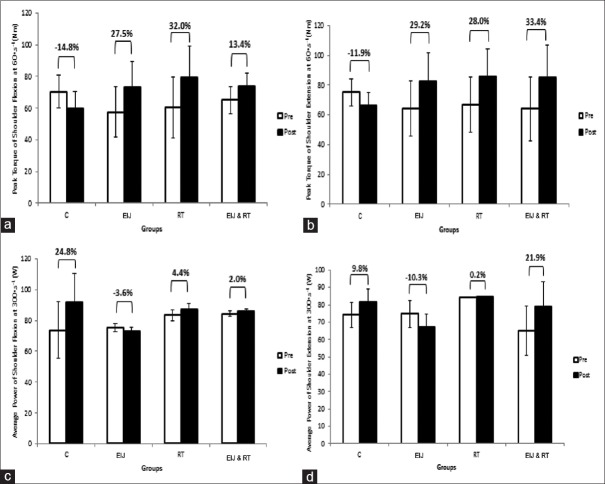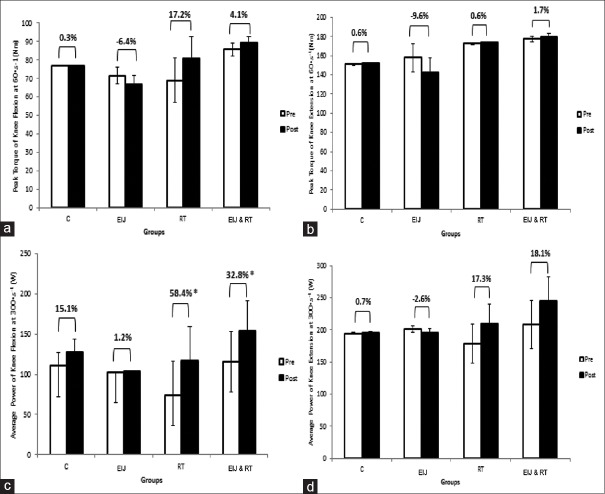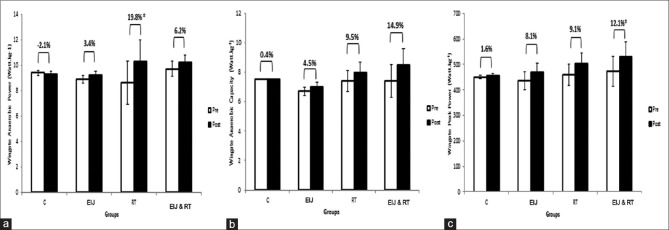Abstract
Introduction:
This study investigated the effects of resistance training and Eurycoma longifolia Jack supplementation on isokinetic muscular strength and power, Wingate anaerobic power, and testosterone: epitestosterone (T/E) ratio in young males.
Methods:
Forty young males were weight-matched and assigned into four groups: control (C), Eurycoma longifolia jack (ElJ), resistance training (RT), and Eurycoma longifolia Jack plus resistance training group (ElJ & RT). Participants in ElJ and ElJ & RT groups consumed 200 mg Eurycoma longifolia Jack daily, whereas participants in the C and RT groups consumed placebo capsules daily for 8 weeks. Resistance training program which consisted of 10 different exercises was conducted three times per week for 8 weeks. Participants' isokinetic muscular strength and power, anaerobic power, and urinary TE ratio were measured before and after the intervention period. This is a randomized placebo-controlled intervention study. Paired t-test and one-way analysis of variance were used for statistical analysis.
Results:
The mean average power of knee flexion at 300°/s in the RT and ElJ & RT groups was significantly (P < 0.05) higher in the posttest compared with pretest. Wingate relative peak power in the RT group increased significantly (P < 0.05) compared with respective pretest value, whereas peak power in the combined ElJ & RT group was significantly (P < 0.05) higher in posttest compared with pretest. There was no significant difference in T/E ratio between pre- and posttests in all the groups.
Conclusions:
The prescribed resistance training program, either with or without ElJ supplementation, improved isokinetic power of the lower limb. Resistance training alone improved relative anaerobic power, whereas combined Eurycoma longifolia Jack and resistance training improved peak power output. ElJ consumption of 200 mg daily for 8 weeks did not affect the urinary T/E ratio.
Keywords: Anaerobic power, Eurycoma longifolia Jack, isokinetic strength, resistance training, testosterone:epitestosterone ratio
Introduction
Eurycoma longifolia Jack is a tall, single-stemmed, slender, shrubby, slow-growing tree, and can be found on sandy soil in Malaysia.[1] It is locally known as “Tongkat Ali” and has been described as the “Malaysian ginseng” due to its popularity among various ethnic groups as a treatment for various diseases and enhancing health.[2]
Eurycoma longifolia Jack contains mainly quassinoids, and other active compounds such as tirucallene-type triterpenes, squalene derivatives, biphenyl-neo-lignans, anthraquinones, canthin-6-one alkaloids, β-carboline alkaloids, and dimeric dihydrobenzofuran.[3] Eurycoma longifolia Jack possesses medicinal properties such as antidiabetic and[4] antibacterial,[5] increases sexual motivation in rats,[6] anxiolytic,[7] antimalarial, cytotoxic, antiulcer and antipyretic,[8] and antitumor.[9] Eurycoma longifolia Jack has also been shown to increase testosterone levels[10] and possesses antioxidant properties.[11,12,13] In addition, it was reported that supplementation of Eurycoma longifolia Jack at a dosage of 400 mg/day for 6 weeks did not affect the urinary testosterone: epitestosterone (T/E) ratio in male recreational athletes.[14]
Several studies have been carried out to investigate the effects of Eurycoma longifolia Jack on sports performance. Ooi et al. (2001) investigated the effects of an herbal drink containing Eurycoma longifolia Jack on cycling performance among young trained male cyclists.[15] This study demonstrated that there was no significant improvement in endurance cycling performance following supplementation of an herbal drink with a dosage of 0.1 mg of Eurycoma longifolia Jack per 100 mL of water. Thus, the authors speculated that this finding could be attributed to inadequate concentration of Eurycoma longifolia Jack that was consumed by the participants at 20 min intervals during the trials.[15] Muhamad et al. (2010) investigated the effects of Eurycoma longifolia Jack on endurance running performance with a higher dosage of this herb and a longer supplementation period in recreational athletes.[16] However, they also reported that Eurycoma longifolia Jack at a dosage of 150 mg daily for 7 days had no beneficial effects on endurance running performance. Nevertheless, it has been previously reported that Eurycoma longifolia Jack supplemented at a dosage of 150 mg for 5 weeks increases the muscular strength of healthy male adults.[17]
Resistance training has been prescribed for improving health, fitness, and also in rehabilitation.[18,19] Resistance training has been shown to increase muscular strength in both children and adolescents, and this increase was attributed to increased neuromuscular activation and co-ordination.[20] A couple of studies carried out in our laboratory have also demonstrated that resistance training using dumbbells and elastic bands elicited improvement in isokinetic muscular power in healthy male adults[21] and in adolescent athletes.[22] Ooi et al. (2015) investigated the combined effects of Eurycoma longifolia Jack and a circuit training program on muscular strength and power in older adult men around 46 years of age. It was reported that the combined circuit training program and Eurycoma longifolia Jack supplementation at a daily dosage of 400 mg for 8 weeks elicited a higher muscular strength and power compared with circuit training alone.[21]
Thus, the objective of this study was to investigate the combined effects of a resistance training program and Eurycoma longifolia Jack on isokinetic muscular strength and power, anaerobic power, and urinary T/E ratio among younger males.
Methods
In all, 44 physically healthy males, between 19 and 25 years of age were recruited in this randomized placebo-controlled intervention study. CONSORT diagram showing the flow of participants through each stage of this study is illustrated in Figure 1. All participants were weight-matched and then randomly assigned into four groups, with 11 participants per group. The participants were given a detailed explanation about the objectives, procedures, benefits, risks, and possible discomforts experienced in this study before signing the informed consent forms. This study was approved by the Human Research Ethics Committee, Universiti Sains Malaysia.
Figure 1.
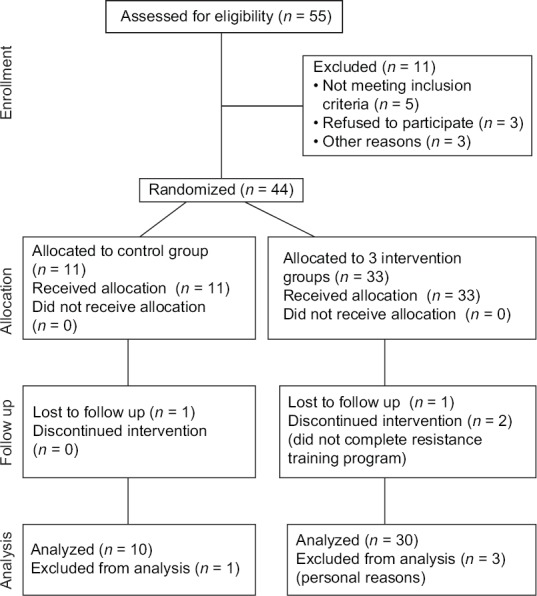
CONSORT diagram showing the flow of participants through each stage of the randomized trial in this study
The participants were divided into four groups: (i) control group supplemented with placebo (C), (ii) Eurycoma longifolia Jack supplemented group (ElJ), (iii) resistance training group supplemented with placebo (RT), and (iv) resistance training group supplemented with Eurycoma longifolia Jack (ElJ & RT). Participants in the ElJ group consumed 200 mg of Eurycoma longifolia Jack daily for a total of 8 weeks. An earlier study using a daily dosage of 150 mg of Eurycoma longifolia Jack did not elicit any significant improvement in endurance running performance. Thus, a higher dosage of 200 mg of Eurycoma longifolia Jack and a longer duration of 8 weeks were used for this study.[16] Participants in the RT group were required to undergo a resistance training program for 8 weeks with three sessions per week and 1 h per session. Participants in the ElJ & RT group were also required to undergo the same resistance training program and consumed 200 mg of Eurycoma longifolia Jack daily for 8 weeks. Participants in the C and RT groups were supplemented with placebo capsules daily for 8 weeks. These capsules were similar in color and texture but contained maltodextrin.
The resistance training program consisted of 10 stations of different activities using either elastic bands or dumbbells. The types of activity were heel raise with dumbbells, lateral raise with elastic band, leg curls with elastic band, bicep curls with dumbbells, leg abduction with elastic band, front raise with dumbbells, knee extension with elastic band, arm extension with dumbbells, half squat with elastic band, and standing chest fly with dumbbells. The number of repetitions for exercises with dumbbells was 10, while exercises with elastic band were 15. The weight of the dumbbells was between 3 and 12 kg while the elastic bands were color-coded in terms of its elasticity. Participants were given 1 min rest between stations before continuing with the next station in the circuit. A 3-min rest was given to the participants before they perform a subsequent set. The participants were required to complete three sets of this circuit and this training program was conducted three times a week for 8 weeks.
Prior to the supplementation regimen and following 8 weeks of experimental period, urine samples were collected for the analysis of urinary level of T/E ratio. Determination of T:E ratio was performed by the staff of the Doping Control Centre, Universiti Sains Malaysia, Penang. Quantification of T:E ratio was determined by gas chromatography-mass spectrometry (GC/MS). Free and conjugated T and E were extracted by solid phase extraction using the Nexus (Varian) column combined with liquid–liquid extraction using tert-butyl methyl ether, followed by hydrolysis using enzyme β-glucuronidase from Escherichia coli K12 (Roche Diagnostics, Mannheim, Germany); extracts were then derivatized with activated N-methyl-N-trimathylsilyl-trifluoroacetamide. Calibration of T was performed using concentration levels of between 2 and 80 ng/mL while the values for E were between 2 and 20 ng/mL. Selected ion monitoring mode with electron ionization on the GC/MS was used for both identification and quantification of both T and E.
Anthropometric measurements were recorded at pre- and postexperimental periods. Body weight, height, body mass index and percent body fat measurements were measured using an electronic weighing machine (Seca 220, Germany) and body composition analyzer (Tanita® TBF-410, Japan). An isokinetic dynamometer (Biodex Medical System 3 Pro, NY, USA) was used to measure isokinetic muscular strength and power of the participants. Two different angular velocities (60°/s and 300°/s) were used to measure isokinetic knee and shoulder flexion and extension muscular strength and power of the participants before and after 8 weeks of experimental intervention.
Participants' anaerobic fitness was determined through Wingate anaerobic test. Wingate anaerobic test is a 30-s all-out exhaustive ergometer test where the participants pedaled on a cycle ergometer (Lode Groningen, The Netherlands) against a resistance. All participants were required to maintain 1 min of cycling at 50 W at 60 rpm prior to the 30-s actual test. During the 30-s test, participants were encouraged verbally by the researcher to pedal as fast as they possibly could. Participants remained seated for the entire duration of the test to avoid unfair mechanical advantage due to involvement of other muscle groups which might skew the results.
Statistical analysis was carried out using Statistical Package for Social Sciences (SPSS) version 18.0 (SPSS Inc., Chicago, Illinois, USA). Normality of all the data was examined with Kolmogrov–Sminov test. Data of age, body height, body weight, and body fat percentage were analyzed by descriptive statistics. Paired t-test and one-way analysis of variance were performed to determine the significance of the differences between and within groups, respectively. The difference was considered statistically significant at P < 0.05. All values are presented as mean ± standard deviation.
Results
Physical characteristics of the participants
One participant from each group withdrew from the study due to personal reasons. Thus, data presented are based on 40 participants who successfully completed the study. Anthropometric data obtained from all participants (n = 40) are summarized in Table 1. There were no significant differences in age, body weight, and height between groups prior to experimental study. However, there was a significant difference in body fat percentage between ElJ and ElJ & RT groups even though the participants were weight-matched [Table 1].
Table 1.
Physical characteristics of the participants
| Parameters | Control (C) | ElJ | RT | ElJ & RT | ANOVA (P) |
|---|---|---|---|---|---|
| Age (years) | 22.3±0.7 | 21.2±0.8 | 20.2±0.6 | 20.3±0.4 | >0.05 |
| Height (cm) | 164.8±1.7 | 164.4±2.1 | 167.5±2.2 | 167.3±1.7 | >0.05 |
| Weight (kg) | 66.4±4.0 | 67.4±4.5 | 64.7±3.6 | 64.3±3.0 | >0.05 |
| Body fat percentage (%) | 22.6±2.6 | 25.3±2.6 | 20.9±2.0 | 18.2±1.7* | <0.05 |
| Body mass index (kg/m2) | 24.3±1.1 | 24.8±1.4 | 23.1±1.2 | 22.3±0.9 | >0.05 |
*Significantly different from ElJ group (P<0.05)
Isokinetic peak torque of shoulder extension and flexion at 60°/s
At pretest, there were no significant differences in isokinetic peak torque of shoulder extension and flexion at 60°/s in ElJ, RT, and ElJ & RT groups compared with C group. At posttest also, there were no significant differences in ElJ, RT, and combined ElJ & RT groups compared with the C group in peak torque of shoulder extension and flexion at 60°/s [Figure 2].
Figure 2.
Shoulder flexion (a) and extension (b) peak torque at 60°/s and shoulder flexion (c) and extension (d) average power at 300°/s at pre- and posttests
Isokinetic average power of shoulder extension and flexion at 300°/s
At pretest, no significant differences inisokinetic average power of shoulder extension and flexion at 300°/s were found between ElJ, RT, and combined ElJ & RT groups compared with C group. After 8 weeks of intervention, there were no significant changes in these parameters in ElJ, RT, and combined ElJ & RT compared with C group [Figure 2].
Isokinetic peak torque of knee extension and flexion at 60°/s
There were also no significant differences in isokinetic peak torque of knee extension and flexion at 60°/s at pre- and posttest between all the groups: C, ElJ, RT, and combined ElJ & RT [Figure 3].
Figure 3.
Knee flexion (a) and extension (b) peak torque at 60°/s and knee flexion (c) and extension (d) average power at 300°/s at pre- and posttests. *Significantly different from the respective pretest values (P < 0.05)
Isokinetic average power of knee extension and flexion at 300°/s
There were no significant differences in average power of knee extension at 300°/s between groups ElJ, RT, and combined ElJ & RT compared with C group at pre- and postintervention [Figure 3]. There was no significant difference in isokinetic average power of knee flexion at 300°/s between ElJ, RT, and combined ElJ & RT groups when compared with C group. However, after 8 weeks of intervention, the mean average power of knee flexion at 300°/s in RT and ElJ & RT groups was significantly higher (P < 0.05) in posttest compared with pretest values.
Wingate anaerobic power, Wingate anaerobic capacity, and anaerobic peak power
Anaerobic power in ElJ, RT, and ElJ & RT groups was not significantly different compared with group C at pre- and posttests. After 8 weeks of intervention, anaerobic power in the RT group increased significantly (P < 0.05) compared with its pretest value [Figure 4]. Anaerobic capacity was not significantly different between ElJ, RT, and ElJ & RT groups compared with the control group at pre- and postintervention [Figure 4]. There was no significant difference in peak power between ElJ, RT, and ElJ & RT groups compared with group C [Figure 4]. After 8 weeks of intervention, anaerobic peak power in the combined ElJ & RT group increased significantly (P < 0.05) compared with its pretest value.
Figure 4.
Wingate relative anaerobic power (a), Wingate anaerobic capacity (b), and Wingate peak power output (c) at pre- and posttests. *Significantly different from the respective pretest value (P < 0.05)
Urinary level of T/E ratio
There were no significant differences in ElJ, RT, and combined ElJ & RT groups compared with C group in urinary level of T/E at pre- and posttests [Figure 5].
Figure 5.
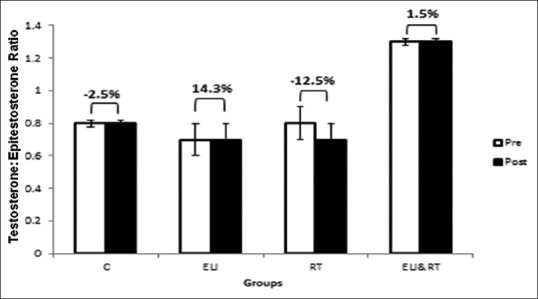
Urinary testosterone: epitestosterone ratio
Discussion
Following 8 weeks of intervention, we observed significant increases in isokinetic average power of knee flexion at 300°/s in the resistance training and combined ElJ & RT groups. For the control and ElJ supplemented groups, there were no changes from pre- to postintervention in both isokinetic muscular strength and average power. These data demonstrated that both resistance training and when combined with Eurycoma longifolia Jack supplementation elicited increases in participants' power of the lower limb. It is postulated that improvement in muscular power from resistance training in this study may be attributed to exercise acting as a stimulus to initiate the relative process of muscular growth. This in turn triggers protein signaling to activate and stimulate synthesis of muscle protein leading to increased muscle strength.[23] Resistance training has been shown to increase the size and number of myofibrils, resulting in hypertrophy of muscle fibers.[24]
The increase in isokinetic strength and power following resistance training in this study also correlates with another study which examined the effects of training with elastic bands on different strength and power adaptations compared with traditional weight training using free weights.[25] In that study, 44 collegiate athletes were recruited and randomly stratified into groups based on their respective sports.[25] The participants were tested prior to and after 7 weeks of resistance training on multiple dependent measures which include 1RM back squat, 1RM bench press, average power, and peak power output in the vertical jump. The results of that study indicated that significant differences were observed between the experimental group (participants who trained with elastic bands for 7 weeks) and control group, suggesting that this type of training may offer an effective means to enhance strength and functional performance.
Although this study failed to demonstrate statistically significant improvement in all the isokinetic muscular strength and power measured, there was a trend of increased strength and power in some of the parameters in the RT and ElJ & RT groups. Thus, future studies with supplementation of ElJ at higher dosage or in different form of ElJ might be warranted. ElJ can be obtained either in the form of raw crude powder where the root is dried and grinded without involving any other chemical processing procedures[26] or in capsules which contain raw crude powder or standardized ElJ extract which is prepared by separating the active ingredients and subsequently concentrating it to a standard level.[26] Eurycoma longifolia Jack is also available as an additive brewed with coffee and canned as processed drinks.[2] Therefore, it is possible that each form might have different absorption rate which may affect the bioavailability of its active ingredients. Ooi et al. (2010) reported that combined Eurycoma longifolia Jack supplementation and a circuit training program increases knee strength and power, shoulder flexion, and extension power. However, this study used a higher daily dosage of 400 mg Eurycoma longifolia Jack for 8 weeks, and it was reported that there was a synergistic effect of the combined Eurycoma longifolia Jack supplementation and the circuit training program on isokinetic muscular strength and power.[21] The synergistic effect of Eurycoma longifolia Jack and resistance training was not observed in this study, and this could be attributed to the different dosage of Eurycoma longifolia Jack consumed by the participants, differences in the types of exercises in the training program, and the age of the participants.
For the Wingate test, our findings indicated that relative peak power in the RT group was significantly higher compared with the other experimental groups. However, anaerobic capacity was not different in any of the groups. As for the peak power, it was significantly higher in combined ElJ & RT group after 8 weeks of intervention period compared with its baseline value. According to Malina et al. (2004), anaerobic peak power reflects short-term anaerobic performance, whereas mean anaerobic capacity reflects intermediate-term performance.[27] In determining the anaerobic performance, factors that play crucial roles are morphological (muscle architecture and fiber type), physiological (efficiency of metabolic pathway), biochemical (substrate availability and accumulation of reaction products), and neuromotor (motor skill and motor unit recruitment). The amount of muscle mass, especially the thigh muscle cross-sectional area, has a direct influence on the absolute anaerobic power output that can be generated. Chromiak et al. also showed that the relative anaerobic power increased significantly following a 4 days per week, 10 weeks of periodized strength training program.[28] The resistance used in that study was such that the participants found it very difficult to complete the final repetitions of the final set (three to four sets, 3–10 repetitions).[28] Therefore, it was possible that heavier resistance used in that study could possibly contribute to a significant increase in the relative anaerobic power.
Eurycoma longifolia Jack is popular due to its aphrodisiac property as it stimulates the production or action of androgen hormones, especially testosterone. In addition, human trials have also demonstrated that ElJ supplementation increases the level of testosterone.[10] The possible mechanism on how extracts of Eurycoma longifolia Jack boost testosterone levels was attributed to the active compounds contained in Eurycoma longifolia Jack. A highly purified extract of Eurycoma longifolia Jack has been shown to have antiestrogenic effect compared with tamoxifen. This antiestrogenic effect of Eurycoma longifolia Jack in turn works by increasing testosterone levels as the same way selective estrogen receptor modulators work. Inhibition of the estrogen receptor in the hypothalamus or as aromatase inhibitors works on changing the androgen: estrogen ratio to favor androgen-lowering estrogen. When circulating estrogen is lowered, the body compensates by elevating androgen output.
The result of this study demonstrated that there were no significant effects of intervention on urinary T/E ratio in all the experimental groups. The urinary T: E ratios of all the participants prior to and after engaging in the resistance training and consuming Eurycoma longifolia Jack supplements were below the threshold limit of 4:1 that was set as the cut-off ratio by IOC. The guidelines given by World Anti-Doping Agency stated that if an athlete has a urinary level for T: E ratio more than 4:1, the sample will be submitted for determination of 13C/12C ratio using isotopic ratio mass spectrometry. This study finding was in line with an earlier study carried out by Chen et al. (2014) who reported that there was no significant change in T:E ratio following 6-week supplementation of either ElJ or placebo.[14]
Conclusions
The prescribed resistance training program for 8 weeks, either with or without ElJ supplementation, seems to be beneficial in improving isokinetic muscular power of the lower limb. In addition, resistance training alone may elicit improvement in anaerobic relative power, whereas combined Eurycoma longifolia Jack supplementation and resistance training may have potential benefit to improve peak power output. Consuming 200 mg of Eurycoma longifolia Jack daily for 8 weeks does not affect the urinary T/E ratio. Hence, we conclude that the prescribed resistance training program alone or in combination with Eurycoma longifolia Jack can be recommended to athletes who want to improve the power of their lower limb. However, more studies with longer duration, different dosages of Eurycoma longifolia Jack, and different types of resistance training program are warranted to confirm its efficacy.
Ethical approval
This study was approved by the Human Research Ethics Committee, School of Medical Sciences, Universiti Sains Malaysia, Kelantan, Malaysia.
Declaration of authorship
All the authors were involved in this study. This research project was proposed and designed by CKC and FKO. This study was carried out by AKNA under the supervision of CKC, FKO, and AMA. This article was initiated by AKNA and subsequently corrected and revised by CKC, FKO, and AMA. FKO performed statistical analysis and interpretation of the results. Article preparation was undertaken by CKC, FKO, AKNA, and AMA.
Financial support and sponsorship
Nil.
Conflicts of interest
There are no conflicts of interest.
Acknowledgments
The authors wish to express their sincere gratitude to all the participants who have participated in this study for their commitment and patience during the study period. They also wish to extend their appreciation to the staff of Sports Science Laboratory for their kind assistance and help throughout the study. The authors sincerely thank Biotropics Malaysia Berhad for supplying the supplements and placebo for this study and the staff from Doping Control Centre (USM), for analyzing urinary T/E ratio.
References
- 1.Ang HH, Cheang HS, Yusof APM. Effects of Eurycoma longifolia Jack (Tongkat Ali) on the initiation of sexual performance of inexperienced castrated male rats. Exp Anim. 2000;49:35–8. doi: 10.1538/expanim.49.35. [DOI] [PubMed] [Google Scholar]
- 2.Jaganath IB, Ng LT. Herbs. The Green Pharmacy of Malaysia. Kuala Lumpur: Vinpress and Malaysia Agricultural Research and Development Institute; 2000. pp. 95–9. [Google Scholar]
- 3.Bhat R, Karim AA. Tongkat Ali (Eurycoma longifolia Jack): A review on its ethnobotany and pharmacological importance. Fitoterapia. 2010;81:669–79. doi: 10.1016/j.fitote.2010.04.006. [DOI] [PubMed] [Google Scholar]
- 4.Husen R, Pihie AHL, Nallappan M. Screening for antihyperglycaemic activity in several local herbs of Malaysia. J Ethnopharmacol. 2004;95:205–8. doi: 10.1016/j.jep.2004.07.004. [DOI] [PubMed] [Google Scholar]
- 5.Farouk AE, Benafri A. Antibacterial activity of Eurycoma longifolia Jack. A Malaysian medicinal plant. Saudi Med J. 2007;28:1422–4. [PubMed] [Google Scholar]
- 6.Ang HH, Sim MK. Eurycoma longifolia increases sexual motivation in sexually naive male rats. Arch Pharm Res. 1998;21:779–81. doi: 10.1007/BF02976776. [DOI] [PubMed] [Google Scholar]
- 7.Ang HH, Sim MK. Eurycoma longifolia JACK and orientation activities in sexually experienced male rats. Biol Pharm Bull. 1998;21:153–5. doi: 10.1248/bpb.21.153. [DOI] [PubMed] [Google Scholar]
- 8.Ang HH, Sim MK. Eurycoma longifolia Jack enhances libido in sexually experienced male rats. Exp Anim. 1997;46:287–90. doi: 10.1538/expanim.46.287. [DOI] [PubMed] [Google Scholar]
- 9.Jiwajinda S, Santisopasri V, Murakami A, Kawanaka M, Kawanaka H, Gasquet M, et al. In vitro anti-tumor promoting and anti-parasitic activities of the quassinoids from Eurycoma longifolia, a medicinal plant in Southeast Asia. J Ethnopharmacol. 2002;82:55–8. doi: 10.1016/s0378-8741(02)00160-5. [DOI] [PubMed] [Google Scholar]
- 10.Tambi MIBM, Imran MK, Henkel RR. Standardised water-soluble extract of Eurycoma longifolia, Tongkat ali, as testosterone booster for managing men with late-onset hypogonadism? Andrologia. 2012;44:226–30. doi: 10.1111/j.1439-0272.2011.01168.x. [DOI] [PubMed] [Google Scholar]
- 11.Tambi MIBM. Standardised water soluble extract of Eurycomal longifolia (Lj100) on Men's Health. Int J Androl. 2005;28(Suppl. 1):27. 25-44. [Google Scholar]
- 12.Tambi MIBM, Kadir AA. Eurycoma longifolia jack: A potent adaptogen in the form of water-soluble extract with the effects of maintaining men's health. Asian J Androl. 2006;8(Suppl 1):49–50. [Google Scholar]
- 13.Tambi MIBM. Standardized water soluble extract of Eurycoma longifolia (LJ199) maintains healthy aging in man. Aging Male. 2006;9:53. [Google Scholar]
- 14.Chen CK, Mohamad WMZW, Ooi FK, Ismail SB, Abdullah MR, George A. Supplementation of Eurycoma longifolia jack extract for 6 weeks does not affect urinary testosterone: Epitestosterone ratio, liver and renal functions in male recreational athletes. Open J Prev Med. 2014;5:728. [PMC free article] [PubMed] [Google Scholar]
- 15.Ooi FK, Singh R, Sirisinghe RG, Suen AB, Jamalullail SMS. Effects of a herbal ergogenic drink on cycling performance in young cyclists. Malays J Nutr. 2001;7:33–40. [PubMed] [Google Scholar]
- 16.Muhamad AS, Keong CC, Kiew OF, Abdullah MR, Lam CK. Effects of Eurycoma longifolia Jack supplementation on recreational athletes' endurance running capacity and physiological responses in the heat. Int J Appl Sports Sci. 2010;22:1–19. [Google Scholar]
- 17.Hamzah S, Yusof A. The ergogenic effects of Eurycoma longifolia jack: A pilot study. Br J Sports Med. 2003;37:464–70. [Google Scholar]
- 18.Pearson D, Faigenbaum A, Conley M, Kraemer WJ. The National Strength and Conditioning Association's basic guidelines for the resistance training of athletes. Strength Cond J. 2000;22:14. [Google Scholar]
- 19.American College of Sports Medicine. American College of Sports Medicine position stand. Progression models in resistance training for healthy adults. Med Sci Sports Exerc. 2009;41:687. doi: 10.1249/MSS.0b013e3181915670. [DOI] [PubMed] [Google Scholar]
- 20.Guy JA, Micheli LJ. Strength training for children and adolescents. J Am Acad Orthop Surg. 2001;9:29–36. doi: 10.5435/00124635-200101000-00004. [DOI] [PubMed] [Google Scholar]
- 21.Ooi FK, Afifah MH, Chen CK, Asnizam AM. Combined effects of Eurycoma longifolia Jack supplementation and a circuit training programme on bone metabolism markers, muscular strength and power and immune functions in adult men. IJERSS. 2015;2:1–10. [Google Scholar]
- 22.Teng W, Keong CC, Ghosh AK, Thimurayan V. Effects of a resistance training programme on isokinetic peak torque and anaerobic power of 13–16 years old Taekwondo athletes. Int J Sports Sci Engineer. 2008;2:111–21. [Google Scholar]
- 23.McArdle WD, Katch FI, Katch VL. Exercise Physiology: Energy, Nutrition, and Human Performance. 6th ed. USA: Lippincott William & Wilkins; 2007. [Google Scholar]
- 24.Fahey TD, Insel PM, Roth WT. Fit and Well. Boston: McGraw Hill; 2013. [Google Scholar]
- 25.Anderson CE, Sforzo GA, Sigg JA. The effects of combining elastic and free weight resistance on strength and power in athletes. J Strength Cond Res. 2008;22:567–74. doi: 10.1519/JSC.0b013e3181634d1e. [DOI] [PubMed] [Google Scholar]
- 26.Mohd Effendy N, Mohamed N, Muhammad N, Mohamad IN, Shuid AN. Eurycoma longifolia: Medicinal Plant in the prevention and treatment of male osteoporosis due to androgen deficiency. Evid Based Complementy Alternat Med. 2012 doi: 10.1155/2012/125761. doi: 10.1155/2012/125761. [DOI] [PMC free article] [PubMed] [Google Scholar]
- 27.Malina RM, Bouchard C, Bar-Or O. Human Kinetics. 2nd ed. Champaign, IL, USA: Human Kinetics; 2004. Growth, maturation, and physical activity. [Google Scholar]
- 28.Chromiak JA, Smedley B, Carpenter W, Brown R, Koh YS, Lamberth JG, et al. Effect of a 10-week strength training program and recovery drink on body composition, muscular strength and endurance, and anaerobic power and capacity. Nutrition. 2004;20:420–7. doi: 10.1016/j.nut.2004.01.005. [DOI] [PubMed] [Google Scholar]



